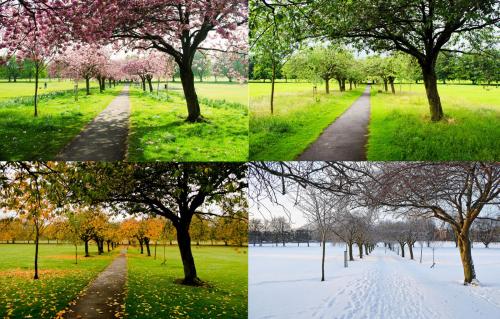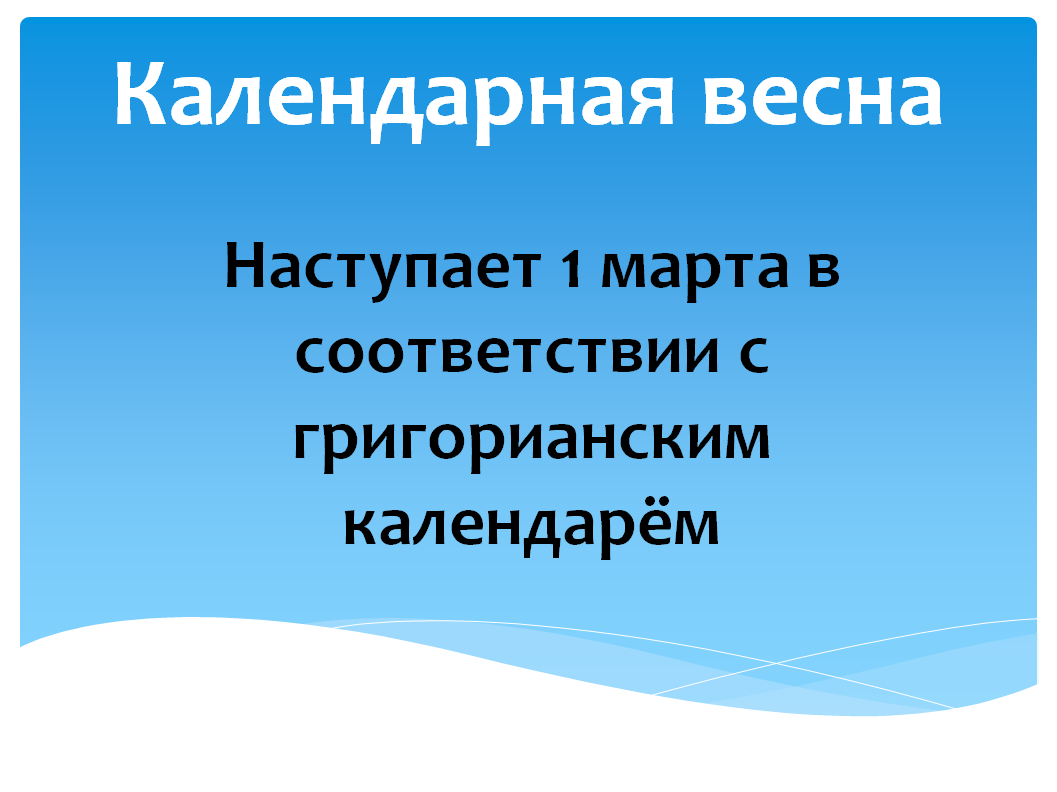16.04.2019
When according to the folk calendar spring comes. Astronomical spring, or the day of the vernal equinox
Start and end of four seasons different countries Europe and America are counted by two methods - astronomical and calendar. In addition, there are meteorological, phenological and cultural principles for determining the beginning of the seasons of the year.
In Russia, it is customary to count according to the calendar principle, so March 1 is congratulated on the first day of spring, and March 8 is considered a spring holiday. But if you read the books of American writers, you can notice turns of speech like "it was at the end of winter, March 10." The thing is, it's in the US. In Canada and many European countries, it is customary to count the beginning of the seasons according to the astronomical principle.

According to the astronomical principle, the beginning of the seasons falls on the days of the solstice:
- spring(March 20 or 21);
- summer(20 or 21 June);
- autumn(September 22 or 23);
- winter(December 21 - 22).
But the solstice different years falls on different days (difference of 1 - 2 days). Therefore, for convenience, in countries where the astronomical method is used, it is usually new season start on the 21st of the respective month. Therefore, it is believed that Catholic Christmas is a holiday that falls at the beginning of winter. However, in everyday life, many Europeans use a simpler calendar principle.
This difference in approach often surprises expats and travelers. It must be taken into account when reading national literature (however, translators usually give explanations in footnotes in such cases).
The astronomical approach also explains the reason for the universal beginning summer holidays in Europe at a later time than in Russia. Holiday ends at European countries ah often falls in mid-September, which also corresponds to the end of the main holiday season.
From a meteorological point of view, the astronomical principle for most European countries is closer to the real beginning of the seasons than the calendar one. December, although it is the darkest month of the year, is usually less cold than March (this is due to climatic inertia - the earth, which has accumulated heat, parts with it more slowly than it heats up). The beginning of June is usually cooler than the beginning of September (this is especially noticeable at sea).
But from the point of view of meteorologists and climatologists exact date there is no beginning of the seasons at all! Winter comes at a time when the average daily air temperature, having stepped over 0 C, tends to decrease. Therefore, in Yakutia, for example, winter sets in at the end of September, and in Krasnodar at the beginning of January. And the summer, which comes with the transition from the average daily air temperature of +15 C upwards, does not come at all in some regions of Russia. For example, in Murmansk it happens only in warm years.

In different eras in different countries, the beginning of a particular season was determined according to cultural and religious traditions. In Ireland, for example, August refers to autumn months, according to Celtic traditions. And in Rus' until the 18th century, the seasons were counted in accordance with major holidays: spring came on the Annunciation (March 25) and lasted until the Nativity of John the Baptist (June 24).
Finally, there is also the phenological principle of determining the onset of a new season - according to the behavior of nature. According to this principle, spring will come when thawed patches appear in the field. And it will end - when the wild rose blooms.
And spring is- fake!
When does spring actually come in Russia? Myths about spring
The first misconception concerns the date of the beginning of spring. Of course, most firmly believe that spring comes on March 1st. Tell the people of Chukotka and Oymyakon about it. In Anadyr at this time, the daytime temperature fluctuates around -20 ... -25, and this is the norm for March 1, and in Oymyakon around -35 ... -40. Where is spring then? And before it is at least a month, and in Siberia and all two!

There is such a thing as a calendar, climatic, meteorological and astronomical spring. Oh how! So, it is the calendar spring that comes in the entire northern hemisphere on March 1, and it has nothing to do with the weather, birds and streams. But what exactly is spring?
Spring is the process of awakening nature after hibernation. And the launch of these processes is directly related to one key indicator - temperature.
March- spring month?
Another misconception concerns the first spring month - March. It has never been spring, March is still winter month. On greater territory Russia average temperature below zero. The rivers are covered with ice, the snow cover has not yet melted, there are frequent arctic intrusions, accompanied by intense snowfalls. March is a winter month. Spring it is only from the point of view of the calendar.
When did it start?
If March 1 cannot be taken as the date of the beginning of spring, then when does it begin? Each region has its own date and depends on the climate. There is a so-called climatic and meteorological spring. How are they different?
climate spring

It should be immediately noted that the date of the beginning of the climatic spring is static. It does not depend on the weather outside the window, but depends on the weather that has been over the past 30 years. It is this period of time that climatologists use to describe the climate. Climatic spring occurs when the average daily temperature passes through 0 degrees in positive side. As a rule, this is the average date, after which the snow melts rapidly, the opening of the rivers begins, and vegetation processes start. Nature comes to life. The real spring is coming! In Moscow, for example, the start date of the climatic spring falls on March 20, and in Yakutsk on April 27. The difference is obvious!
But in some cases, winter is delayed and spring does not come even after the start date of climatic spring.
meteorological spring

The onset of this spring is directly related to the thermometer readings. Therefore, the date of the onset of meteorological spring is dynamic, and every year falls on different dates. Meteorological spring comes when the average daily temperature crosses the zero mark and holds steady for five or more days. For example, in 2015 in Moscow meteorological spring came already on February 20! Of course, in this case, the meteorological spring came earlier than the climatic one, so it can be considered early.
astronomical spring

It's even simpler here, as the name implies. Astronomical spring comes on the day spring equinox and most often this date falls on March 20. March 20 - the day of the onset of astronomical spring. At this time, the Earth is in such a position with respect to the Sun, when both hemispheres, from the equator to the poles, heat up relatively equally. This happens twice a year: on March 20 - on the day of the spring equinox and on September 23 - on the day of the autumn equinox.
Since March 20, the seasons in the hemispheres are changing, astronomical autumn comes in the Southern Hemisphere of the Earth, and astronomical spring comes in the Northern Hemisphere, which lasts until the day summer solstice(21st of June). After the day of the vernal equinox, spring warmth always comes, no matter how cold it was before.
Outcome
The question arises, what spring date should be taken as a standard, so as not to be mistaken? This is a climatic spring, the date of which depends on the climate of the region. Below is an indicative table for different cities of Russia.

The average timing of the onset of climatic spring in different cities Russia
When spring comes in St. Petersburg, Novosibirsk, Yekaterinburg, Nizhny Novgorod, Kazan,
Chelyabinsk, Omsk, Samara, Ufa, Rostov-on-Don, Krasnoyarsk, Perm, Oymyakon, Tiksi, Khabarovsk, Vladivostok, Magadan, Murmansk, Salekhard, Kurgan, Tyumen, Khatanga. When does spring come?
March 21 - the day of the onset of astronomical spring, it is also called the day of the vernal equinox. At this time, the Earth is in such a position with respect to the Sun, when both hemispheres, from the equator to the poles, heat up relatively equally. This happens twice a year: on March 21 - on the day of the spring equinox and on September 23 - on the day of the autumn equinox.
From March 21, the seasons change in the hemispheres, astronomical autumn begins in the Southern Hemisphere of the Earth, and astronomical spring begins in the Northern Hemisphere, which continues until the summer solstice (June 21). After the day of the vernal equinox, spring warmth always comes, no matter how cold it was before.
The ancient scientists of China, India, and Egypt knew very well about the days of the vernal equinox. In ancient times, the days of the spring equinox were considered a great holiday. Nature is reborn again, bears wake up, animals begin to lead a more active lifestyle, preparing for procreation.
In religion in ancient times, the day of the vernal equinox was also of no small importance. The date of the Easter holiday, which is celebrated every year in different time, was counted from the day of the vernal equinox as follows: March 21 - the first new moon - the first Sunday, which was considered a holiday.
It all started in 325 AD, when the Council of Nicaea took place, at which the Julian calendar was adopted for everything Christendom. By decree of the Council of Nicaea, the equinox had to "forever" fall precisely on March 21, as it was in the year of the council, but at the end of the 14th century. Christian church suddenly discovered that the spring equinox no longer coincides with March 21, and moreover, every 128 years it comes one more day earlier, and when the mistake was noticed, the difference was already 10 days: according to the Julian calendar, the equinox should have occurred on March 21, and in fact, it was already on March 11th. This was pointed out by many astronomers, and the clergy more than once intended to carry out a reform, but each time it was postponed for different reasons. Finally, Pope Gregory XIII announced a competition for the best draft of a new calendar. The project of the Italian mathematician Lilio won. And in 1582, the pope issued a special bull, according to which the count of days was moved forward by 10 days and Friday after Thursday, October 4, 1582, it was prescribed to count not October 5, but October 15. This immediately corrected the error that had accumulated since the Council of Nicaea, and the spring equinox again fell on March 21.
Many peoples have kept the spring equinox as a holiday in the calendar. For example, in Farsi it is called Nowruz, which means "new day". Rooted in the traditions of the ancient farmers of the Middle East and Central Asia, the holiday has become an integral part of the culture of many peoples who profess Islam. In the CIS, it is celebrated as a national Tatars, Kazakhs, Bashkirs, Kyrgyz, Tajiks, Uzbeks and many other peoples. In a number of countries, Navruz is declared a public holiday, and March 21 is a day off. In Japan, the day of the spring equinox is celebrated - Shunbun no hi. The week period beginning three days before the vernal equinox is called Higan. At this time, the Japanese visit the graves of their ancestors, and cherry blossoms bloom in the gardens.
In Russia, most of all they rejoice that the daylight hours will increase every minute and the long-awaited summer will come.


